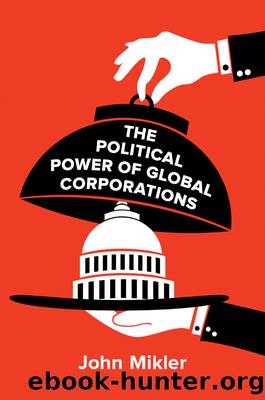The Political Power of Global Corporations by Mikler John;

Author:Mikler, John; [Mikler, John]
Language: eng
Format: epub
Publisher: Polity Press
Published: 2018-01-30T00:00:00+00:00
Emerging Market Economies
If neither the established industrialized states nor the corporations from them must converge on the LME model, this seems even more the case for the newly emerging market economies of the BRICs. Prior to the rise of China and the other emerging market economies of the BRICs, the states that âmatteredâ most were the US and those comprised by the EU. As such, a global economy centered around the transatlantic with an emerging East Asia produced the geographically triadic relations referred to in much of the literature (e.g., see Hamilton and Quinlan 2005; Andersen et al. 2008). It also means that states like China are âwhite space(s) on the map of the VOC debateâ because the VOC approach âwas developed exclusively in the context of âadvanced capitalist nationsââ (Peck and Zhang 2013, 2â3). The BRICs vary institutionally, as states within the LME and CME categories do, but nevertheless they share similarities in their corporate-state relations. As Goldstein (2013a, 2007) notes, in the process of their development the BRICsâ global corporations were either state-owned or -controlled. In the cases of China and Russia, in the early 1990s state ownership was the case for all production, while 44 percent of the turnover of Brazil's largest firms was accounted for by the state (Siffert and Souza e Silva 1999). If it was not the state that was in control, then the main private shareholders for Indian and Brazilian corporations were often families. Their management was comprised of âfirst-generation self-made mogulsâ (Goldstein 2013b, 57) with engineering degrees rather than business qualifications, who had close links with the state as well as their families. Relatedly, there was a very low degree of internationalization in their operations, so that they were almost exclusively national before they became global corporations. This is why in 1990 none of them appeared in UNCTAD's rankings of the most transnational corporations.
The results can be seen in the structures and relations exhibited by the BRICsâ corporations today. National firms dominate the lists of their major corporations, still often family if not government controlled. In the case of China, nearly all its new global corporations remain state-owned enterprises. For private Chinese global corporations such as Haier, Huawei, and Lenovo, âManagers and workers own the company's shares under the supervision of the local governmentâ (McGregor 2010, 202). In fact, Liu and Sun (2005, 48) find that âthe state is in the ultimate and absolute control of 81.6 percent of all publicly quoted companies via two control patterns: (1) government direct control of 9 percent of the quoted companies, and (2) government indirect control of 72.6 percent of the listed companies via stock pyramids.â As such, corporate ownership remains highly concentrated, with the state being the largest shareholder in the country's major listed corporations. Less than 1 percent of A-listed companies on the Chinese stock market are widely held (Bianco 2010; Amit et al. 2010). As a result, Breslin (2012, 32; see also Beeson 2009) finds that there is âa symbiotic relationship (at
Download
This site does not store any files on its server. We only index and link to content provided by other sites. Please contact the content providers to delete copyright contents if any and email us, we'll remove relevant links or contents immediately.
The Fifteen Biggest Lies about the Economy: And Everything Else the Right Doesn't Want You to Know about Taxes, Jobs, and Corporate America by Joshua Holland(1090)
The Economist (20210109) by calibre(897)
The World For Sale by Javier Blas(824)
Made in China by Anna Qu(813)
Philippines--Culture Smart! by Culture Smart!(670)
Boom and bust a global history of financial bubbles by Quinn William Turner John(658)
Mission Economy by Mariana Mazzucato(654)
Forex Trading All In One For Dummies by Mishra Mamta(641)
Big Money by Kenneth P. Vogel(627)
The Money Revolution by Anne Boden(620)
The Dictatorship of Woke Capital by Stephen R. Soukup(617)
The New Retirement Savings Time Bomb by Ed Slott(605)
Tax the Rich! by Morris Pearl(600)
Cross Winds: Adventure and Entrepreneurship in the Russian Far East by Myers Steven(592)
The Inflation Myth and the Wonderful World of Deflation by Mark Mobius(587)
Fundamentals of Finance by Mustafa Akan Arman Teksin Tevfik(564)
The Great Demographic Reversal by Charles Goodhart & Manoj Pradhan(555)
European Yearbook of International Economic Law 2017 by Marc Bungenberg Markus Krajewski Christian Tams Jörg Philipp Terhechte & Andreas R. Ziegler(554)
Business Recoded by Peter Fisk(543)
